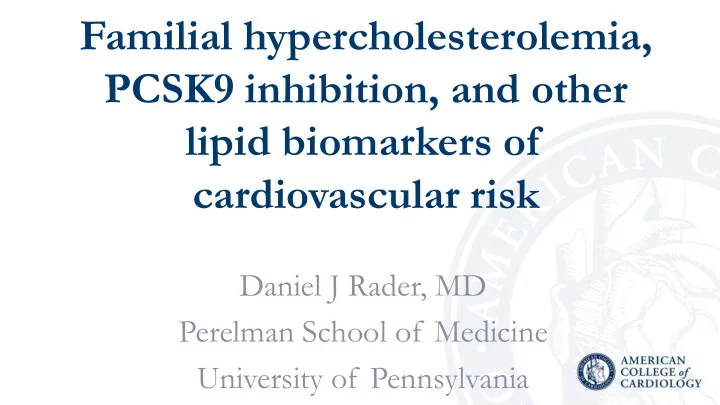

Familial hypercholesterolemia, PCSK9 inhibition, and other lipid biomarkers of cardiovascular risk Daniel J Rader, MD Perelman School of Medicine University of Pennsylvania
Genomic and Precision Medicine in Prevention Preventive and therapeutic interventions
Linking genomic and phenomic data at scale Electronic health records Genotyping and sequencing Deep phenotyping
Familial hypercholesterolemia: mutations in genes that impair LDL receptor function B apoB VLDL TG X FH Ge Gene nes LDLR B X LDL LDLR B * PCSK9 APOB B B *PCSK9
FH is grossly underdiagnosed in the US and most of the world Eur Hea eart rt J. 2013;3 ;34(4 (45):3 ):3478-3490. . doi:10 i:10.1093/eurh eurhea eart rtj/eh eht2 t273
A ‘Genome - first’ approach to finding undiagnosed patients ients with h Familia ilial l Hyper ercholest holesterolem olemia ia FH prevalence: ~ 1 in 250
FH is a CDC- designated ‘Tier 1’ genetic health condition CDC has designated three ‘Tier 1’ genetic health conditions for application of genomic medicine to public health: 1. Hereditary Breast and Ovarian Cancer (HBOC) Syndrome 2. Lynch Syndrome (colon cancer and other cancers) 3. Familial Hypercholesterolemia (FH) Significant public health concerns Effective preventive therapies Autosomal dominant conditions Family screening for FH saves lives
Addressing barriers to care in FH • Increase awareness of prevalence and severity • New ICD10 code (E78.01) • Promote systematic approach to cascade screening and genetic testing • First FH disease registry • Find all the undiagnosed cases
FH: Call to action Make the diagnosis: FH Diagnosis app, ICD 10 E78.01 Educate the patient: thefhfoundation.org Consider genetic testing Actively promote family-based cascade screening Evaluate other risk factors [ie Lp(a)] Aggressively treat LDL, including combination therapies Refer for clinical trials where appropriate
Inherited Syndromes of Extremes of LDL-C: Story of PCSK9 Frequency (%) Loss of function Gain of function mutations in PCSK9 mutations in PCSK9 LDL-C
The Role of PCSK9 in the Regulation of LDL Receptor Expression For illustration purposes only 14 14
Impact of an PCSK9 mAb on LDL Receptor Expression For illustration purposes only mAb 15 15
PCSK9 Inhibitors • Alirocumab and Evolocumab • SQ injection biweekly or monthly • Indications: – Patients with heterozygous familial hypercholesterolemia on maximally tolerated statin therapy with inadequate plasma LDL levels – Patients with a history of CHD with inadequate plasma LDL levels • Reduce cardiovascular outcomes (FOURIER)
LDL Cholesterol 100 Placebo 90 80 LDL Cholesterol (mg/dl) 70 59% mean reduction (95%CI 58-60), P<0.00001 60 Absolute reduction: 56 mg/dl (95%CI 55-57) 50 40 30 Evolocumab 20 (median 30 mg/dl, IQR 19-46 mg/dl) 10 0 0 12 24 36 48 60 72 84 96 108 120 132 144 156 168 Weeks An Academic Research Organization of Brigham and Women’s Hospital and Harvard Medical School
Primary Endpoint 16% Hazard ratio 0.85 14.6% 14% (95% CI, 0.79-0.92) P<0.0001 Hosp for UA, or Cor Revasc 12.6% Placebo 12% CV Death, MI, Stroke, 10% 8% Evolocumab 6% 4% 2% 0% 0 6 12 18 24 30 36 Months from Randomization An Academic Research Organization of Brigham and Women’s Hospital and Harvard Medical School
Substantial residual risk of CV events remains even in patients treated to very low levels of LDL-C
Lipoproteins and Coronary Disease Remaining opportunities for reducing residual risk through lipid modulation
ApoB-lipoproteins are biomarkers of CAD risk Lipoprotein class Clinical trait Association with CAD LDL cholesterol Triglycerides Lipoprotein(a)
TG-rich lipoproteins are causally related to coronary disease TG B TG-rich lipoproteins
Lipoprotein lipase is a critical regulator of TG-rich lipoprotein metabolism TRLs TRL remnants LPL Endothelium of tissue capillaries
ApoC3 inhibits metabolism of TG-rich lipoproteins and is a genetically validated therapeutic target ApoC-III TRLs TRL remnants LPL
Volanesorsen (ASO to APOC3 ) reduces apoC-III and TGs
Other proteins influencing the LPL pathway are genetically validated targets ApoC-III ANGPTL3 ANGPTL4 TRLs TRL remnants LPL ApoA-V
Blood biomarkers that predict risk of and are causal for cardiovascular disease • Lipoprotein(a) [Lp(a)]
An ASO to APO(a) reduces Lp(a) levels in humans Mark J. Graham et al. J. Lipid Res. 2015;57:340-351; Tsmikas et al, Lancet 2015
HDL-C is a strong inverse predictor of CAD risk but is NOT causally associated with CAD A-I HDL X
ApoA-I I promotes es macr crop ophag hage e cholest lester erol ol ef efflux flux and d rever erse se cholest lester erol ol tr trans anspor port Bile le A-I A-I ABCG1 FC FC LCAT CE CE FC FC FC FC FC FC CE CE SR-BI SR BI ABCA1 Liver er Mac acrop ophage ge “Cholesterol efflux capacity” of HDL is pr predi edictiv ctive e of of cardio diovascular ascular event ents
Will apoA-I/reconstituted HDL remove cholesterol from plaque and reduce CV events after ACS?
Lipid management in high-risk patients A-I B LDL, TG-rich HDL lipoproteins, Lp(a) • High-intensity statin therapy If HDL-C is low: • Target LDL-C aggressively, using Lifestyle intervention combinations as needed High-intensity statin therapy • Non-HDL-C and possibly TG-rich Consider TG reduction if TGs lipoproteins as secondary targets are elevated • Enroll in clinical trials of new lipid- lowering therapies
Recommend
More recommend